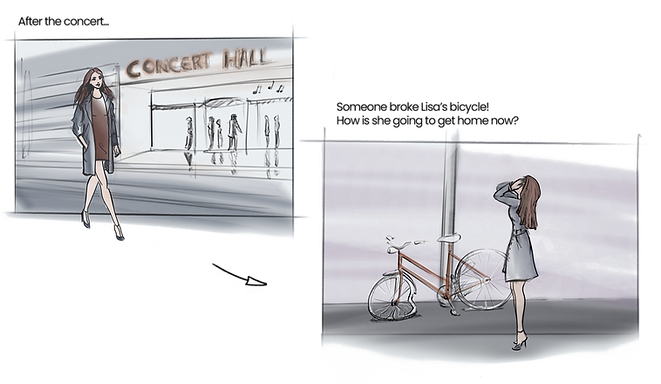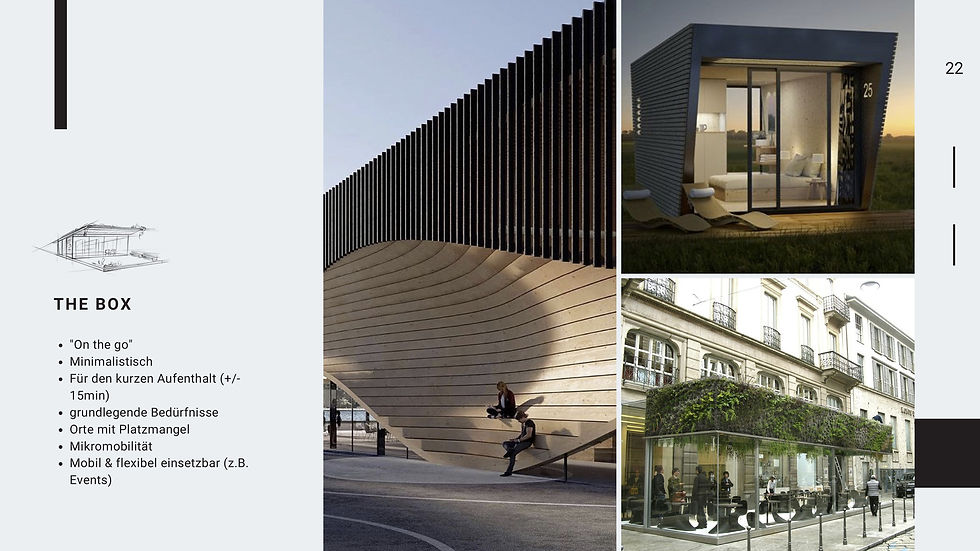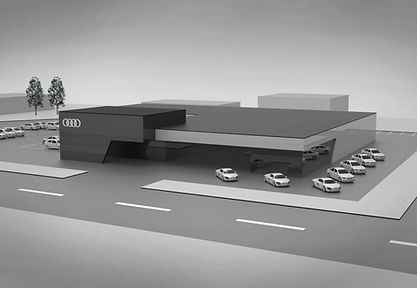
02
Case
Study
Designing Audi’s Next Mobility Experience
Project Title: What Moves Us?
As the mobility landscape shifts, Audi, like many automotive brands, is navigating a transformation. Emerging user needs, technological advancements, and changing societal values are challenging the traditional role of the car and the dealership.
Challenges
-
What role could physical spaces play in a service-driven, digital ecosystem?
-
How can Audi extend its premium brand identity into new forms of mobility experience?
-
How can existing infrastructure evolve to meet future user needs while staying true to the brand?
-
How might Audi remain relevant in a world where ownership is no longer central to mobility?
Overview
What moves us? This question became the starting point for my exploration into the future of mobility. It invited me to look beyond the obvious, to explore not just how we move, but why. What motivates people? What shapes our habits? And how are brands like Audi connected to these evolving needs?
Process
Design Research · Problem Framing · Ecosystem Mapping · User Needs Analysis · Brand Strategy Alignment · Persona Development · Journey Mapping · Ideation & Concept Development · Service Design · Scenario Prototyping · Visual Storytelling
Tools
Adobe InDesign, Illustrator, Photoshop, Sketching, Rhino 3D, Maya, Keyshot, Physical Model Making
Team
Solo Project that became Thesis at AUDI Design
Duration
12 Months, 2019
Process
-
Literature Research
-
Interviews at Audi (internal)
-
Analysis of Research Findings
-
Development of Hypothesis
-
Design Concept Development for Design Language, Interior & Exterior
-
2D Visualization of the Mobility Hub
-
CAD Visualization of the Hub
-
Interview with Future Center VW Group
-
Visit to Audi Denkwerkstatt in Berlin
-
Testing Micro-Mobility in Berlin
-
Interview at Audi City Berlin
-
Visit to DRIVE in Berlin
-
Strategy for Presentation
-
Model Making at Makerspace, Ingolstadt
-
Exhibition of the Strategy Board
-
Key Takeaways
Research & Empathize
Level 01 - Societal Transformation
The project began with a simple question:
What defines a meaningful mobility experience today, but also in the future?

Strain on Urban Infrastructure
Urbanization, environmental concerns, and stricter political regulations are transforming how people move. As cities grow and infrastructures reach their limits, there is an urgent need to redesign mobility systems to be more connected, sustainable, and user-centered.

Many journeys today are multimodal — the best mobility experiences arise when all modes of transport connect seamlessly.
The Future of Mobility: Focusing on Mobility Touchpoints
Urban mobility is deeply influenced by the unique fabric of each city. Yet, some challenges—like enabling smooth transitions between different transport modes—are universal. This project concentrates on those shared pain points. Multimodal intersections, in particular, offer a future-proof opportunity: they’re relevant today and will be indispensable tomorrow, as cities grow and systems become more complex.

Societal and political shifts are creating new conditions for the mobility sector. Cities are prioritizing intermodal mobility, introducing concepts like Zero Emission Zones, diesel bans, and congestion charges to reduce traffic and improve urban life. Some future models even envision fully car-free city centers. These changes demand innovative design responses that support cleaner transport systems and ease the strain on urban infrastructure.

Opportunity:
Mobility Provider (Audi)
= Key Enabler for Mobility Transformation
Changing mobility habits open new opportunities for mobility providers. By offering guidance, sharing information, and encouraging active participation, they can help citizens navigate and shape the transition.
Designing "the space in between"
Mobility is no longer just about moving from A to B. It is also about how people experience the spaces in between. What users truly seek goes beyond speed or access. They want orientation, emotional ease, and a sense of being supported when switching between transport modes. Audi, as a mobility provider, has the opportunity to take on the role of a trusted guide in this time of transformation.
Level 02 - AUDI's Transformation
How can Audi evolve its premium brand to remain relevant as a mobility provider?
In response to accelerating societal change, Audi is being challenged to rethink its core identity and long-term role. The transformation from a traditional car manufacturer to a mobility provider is not just a strategic ambition, but a necessary step to remain relevant in a world shaped by sustainability, digitalization, and shifting customer expectations.

Redefining Premium - Meeting new Societal Demands
Audi is redefining what premium means in this new context, focusing on intelligently connected products that offer customers greater freedom, time, and autonomy. At the same time, the brand is committing to CO₂-neutral premium mobility, aiming to lead the electric vehicle segment and operate company-wide carbon neutral by 2050. These shifts require not only innovation, but a deep understanding of how mobility must evolve to meet individual needs and societal demands. (Audi, 2019)

While mobility continues to change, one thing remains consistent: the need to switch between different modes of transport. These mobility intersections present a valuable opportunity for brand positioning because they will remain relevant in the future.
Opportunity for AUDI - Mobility Experience becomes Brand Experience
-
Enhancing the brand experience alongside the mobility experience
-
Expanding the Audi infrastructure portfolio
-
Evolving from a manufacturer to a service provider
-
Gathering mobility data
-
Increasing brand visibility in daily mobility routines
-
Reaching new target groups
-
Gaining competitive advantage
Key Question
How can Audi create a premium, user-centered brand experience at mobility intersection using its existing strengths and infrastructure?
Level 03 - Car Dealerships Transformation
In Germany, Audi already has a strong physical presence with over 400 dealerships and more than 1,000 certified service stations. That adds up to over 1,400 customer touchpoints—comparable to the scale of McDonald’s national footprint. This existing network holds enormous potential to support Audi’s transformation toward e-mobility and its role as a mobility provider.

Opportunity
Leverage the existing Dealership Network
The role of car dealerships is also changing. More customers are turning to online platforms or direct sales channels to buy vehicles. At the same time, the shift to electric vehicles reduces service-related revenue for dealerships, which previously relied heavily on tasks like oil changes. In light of these changes, dealerships are now asking an important question:
What role will physical retail spaces play in the future of mobility?
Hypothesis
Leading the Transformation
If Audi transforms its widespread dealership network into future-ready mobility hubs, it has the unique opportunity to turn static retail spaces into dynamic brand experiences—preserving its premium status while leading the shift toward seamless, sustainable, and user-centered mobility.

Define & Test
Designing Mobility Intersections
How might we transform Audi’s dealership network into meaningful mobility touchpoints that support the brand’s evolution while enhancing customer experience?

Who are the users and what are their needs?
Mobility intersections are the points where users switch between transport modes. Mobility hubs function as key infrastructure at these intersections. They enable seamless, multimodal travel and offer the potential to improve the overall mobility experience through smart and connected design.
Persona
Profile: Lisa, 32 years old
-
Lives in a large city (e.g. Berlin, Munich)
-
Works freelance and commutes to different locations
-
Doesn’t own a car and doesn’t plan to
-
Frequently uses public transport, e-scooters, bike sharing, ride-sharing
-
Prioritizes flexibility, time-saving, and ease in daily life
Goals
-
Reduce daily stress related to commuting
-
Feel more in control of her mobility choices
-
Improve her quality of life through smarter, smoother movement
-
Invest in mobility that aligns with her values: sustainable, flexible, efficient
Pain Points
-
Frustration during mode-switching (orientation, timing, accessibility)
-
Overcrowded or unreliable connections
-
Lack of comfort or premium feel without owning a car
-
Inconsistent experiences across mobility services
Needs
-
Seamless transitions between transport modes
-
Real-time, user-friendly mobility information
-
Clean, safe, and comfortable waiting or switching zones
-
Services that respect her time, energy, and lifestyle
How to turn Customers into Fans

What turns a mobility intersection into a high-value urban hotspot?
-
Social Interaction
-
Use & Activities
-
Comfort & Appearance
-
Access & Connectivity
Core Values for Customer Satisfaction
-
Stimulation: Curiosity, Entertainment Distraction
-
Security: Relaxation, Predictability, Structure
-
Popularity: Gain recognition, Have influence
-
Autonomy: Independence, Freedom
-
Competence: Experience success, Feel effective
-
Connectedness: Social inclusion, Closeness
-
Meaning: meaningful and gain new insights
User Insight: The Transfer Scenario
Mobility intersections are emotionally charged moments. Users often experience boredom, confusion, discomfort, and stress while waiting or switching between modes of transport. Public mobility spaces are frequently overcrowded, poorly maintained, and lack atmosphere or a sense of safety. This makes them unsuitable for premium brand experiences — but also reveals a clear opportunity: to redesign these spaces into inviting, brand-aligned environments that support user needs and turn passive waiting into meaningful moments.




Key Learning: Waiting Time Can Be Valuable
Waiting is often perceived as lost time. But research shows that the experience of waiting improves when it feels fair, explained, social, and worthwhile (Maister, 2005). The more valuable the service, the more willing people are to wait. With the right design, waiting can become a moment of reflection, inspiration, or micro-recovery, a pause that enhances rather than disrupts the mobility journey.
Waiting Time = Premium Time
Brand Loyalty Through Positive Mobility Experiences
Storyboard









Ideation & Visualization
Defining New Aesthetics for Audi Mobility Beyond the Car
How might we create a distinctive design language for Audi that translates premium brand values into seamless, non-automotive mobility experiences?
How might we transform Audi’s dealership network into meaningful mobility touchpoints that support the brand’s evolution while enhancing customer experience?

Exploring new Visual Values


Versatile
Modern
Technical
Confident
Honest
Natural
Personal
Inviting
Dynamic
Versatile
Modern
Confident
Assured
Premium
Natural




Natural
Personal
Sustainable
Comfortable
Versatile
Dimensions & Modular Design
Opportunity: Corporate Identity Display through design elements and brand experiences.


THE GIANT
THE BOX
Canopy for Electric Car Charging Station
90 degrees rotate
Mobile Architecture for maximum flexibility
THE MEDIAN
E-Bike charging station
Modular Design
for a Scalable and Flexible Brand Presence
Modular elements designed with a unified visual language across all product variations.
Exploring Scenarios




Design
Scenario
Design in Context: A Sample Scenario

STATUS QUO

What?
Transformation of the Audi Dealership XYZ into:
-
An extension of Audi’s vehicle and service infrastructure (e.g. Vehicle on Demand, Mobility on Demand)
-
A mobility station connected to public transport, micro-mobility, ride- or car-sharing, and shuttle services
-
A service station for vehicles (functions: repair, charging, cleaning, maintenance)
-
A customer-centered point of contact and sales location for the Audi brand
-
A hub for Audi mobility and customer consultation
Enabled by:
-
Utilization of existing structures + strategic expansion
-
Integration of third-party services and offerings
Where?
Hybrid City:
A dense urban center with a strong public transport network and well-developed road infrastructure, surrounded by expansive suburban areas. Both public transit and street infrastructure are simultaneously being expanded.
For Whom?
-
Users of Audi vehicles and mobility services
-
Commuters seeking comfort and efficient time use
-
Business clients who want flexible, digital workspaces
-
Leisure users looking for new experiences and inspiration
-
Families who want alternative mobility solutions
-
Anyone who supports and lives the cultural shift toward alternative mobility concepts
From Design Requirements to Functional Features
When selecting the functional and spatial elements for the hub, the previously researched dynamics between society, Audi, dealerships, and customers were translated into a design goal: achieving a balanced experience that integrates functionality, comfort, safety, accessibility, privacy, interaction with the environment, and aesthetic quality.

Design Elements
-
Materials
-
Colors
-
Shapes
-
Graphics / Patterns
-
Lighting
-
Decorations
-
Logo
-
Packaging
Design Components
Interior
-
Flooring
-
Ceiling
-
Walls
-
Counter front
-
Space dividers
-
Tables
-
Seating options
-
Lighting
-
Sales area / product displays
-
Information surfaces
-
Digital displays
-
Vending machines
-
Charging stations (e.g. for phones)
-
Kids’ play area
-
Sanitary facilities
-
Conference booth / room
-
Event space
-
Art & decoration
-
Designated resting areas
-
Service point
-
Third-party services
-
Restaurant / café
Connectivity
-
Parking for electric vehicles
-
Autonomous vehicles
-
Sharing area
-
Taxi area
-
Rental area
-
Micro-mobility
-
Public transport connection
-
"Third dimension" landing area
Exterior
-
Digital elements / screens
-
Vital elements (greenery, water features, water dispensers, etc.)
-
Seating options
-
Tables
-
Wayfinding signage
-
Sun and rain protection
-
Lighting
-
Service point
-
Info point
-
Third-party services
Green Hub
-
Vital elements
-
Recycling
-
Solar panels
-
Wind energy
-
Educational installations
-
Energy-efficient façade and roof
-
Energy consumption systems (heating, cooling, hot water, lighting)
Service Hub
-
Service features for cleaning, maintenance, repair etc
-
Space for quick replacement of modular interior elements
-
3D printer
-
Luggage service
-
Third-party services
-
Charging stations
-
Lockers
-
Service point
Scenario: Medium-sized dealership
User-Centered Hub Layout // Spatial Strategy
To develop an effective layout for the Audi Hub, key use cases were analyzed and translated into functional and spatial elements. A core principle of the transformation was modularity: new elements can be gradually integrated into the existing structure. For example, the workshop remains fully operational throughout the process, avoiding the need to relocate service infrastructure. As demand increases, the space can expand accordingly.

Workshop
Extension
Office
Office
Workshop
Third-Party Services
Consultation
Services
Café
Brand Values & Products
Business & Leisure Lounge

Status Quo

The former vehicle presentation hall becomes a central showroom that not only displays Audi vehicles and products but also communicates the brand’s values in a tangible way. At its core sits a large consultation and service area—symbolizing Audi’s customer-first approach.
Tailored waiting zones for business and leisure users are located in an adjoining architectural extension at the front of the building. This new signature element makes the transformation into an Audi Hub visible from the outside. Inside, the layout and use of glass walls guide the customer’s gaze directly toward the presentation space—creating a seamless connection between brand, product, and experience.


Interior
Design
Brand Values in the Interior

Confidence
Technology
Self-assurance
Modernity
Sense of Proportion
Honesty
Clarity
Empathy
Premium Quality
Versatility
Inclusive / For Everyone
Dynamic
Light & Shadow
Sustainability
Naturalness
Personal
Comfort
Inviting

Control of Space
= Freedom in Space
-
A sense of freedom emerges through self-determination
-
Flexible spaces where users can control the level of stimulation
-
Autonomy through adjustable furniture, work surfaces, and seating
-
Customizable lighting, adaptable room sizes, movable partitions, and privacy features for conversations create a sense of control and comfort

Personal Space
= Premium Space
-
A balance between privacy and social connection is essential
-
Privacy can be regulated through control of accessibility, visibility, proximity, sound, and scent

Brand in Space
-
Highlights Audi’s connection to society and the environment
-
The service desk area symbolizes customer centricity
Brand Experience Zone
Product Display
Customer and Mobility Consultation

Business Lounge
-
Business use case addresses key needs: competence, meaning, stimulation, security, and autonomy
-
Interior elements are designed to enhance productivity while providing high-quality relaxation opportunities
-
Access via membership card
-
Bookable meeting rooms for private or digital meetings
-
Power nap and relaxation zone with ambient lighting and comfortable lounge furniture
-
Central co-working area for flexible work setups

Leisure Lounge
-
Focus on entertainment and social connection
-
Leisure use case addresses key needs: connectedness, popularity, stimulation, autonomy, and safety
-
Seating areas arranged in small groups to encourage conversation between fellow travelers
-
Digital displays provide real-time departure updates and, together with interactive design elements, offer engaging entertainment during waiting times

Strategy
Presentation
The Strategy Board



The Landscape of Mobility Transformation
The strategy board was designed as a three-dimensional display surface to visually represent the core elements of my concept. Its form is inspired by topographic maps, where layered elevations represent geographic space. In my thesis, the strategy board symbolizes the landscape of mobility transformation.
The different material layers distinguish the spheres of action within various thematic categories. The 3D structure offers viewers a clear overview of the bigger picture, gradually guiding them deeper into the concept and its design details.
Model Building
The model-building phase was a hands-on exploration of material and form.
It included detailed material studies, the integration of text and graphic elements, and extensive experimentation with laser-cutting Kapa board. Through a process of trial and error, I refined both the technique and composition, translating the conceptual structure of the strategy board into a layered spatial representation.



Presentation

Key Takeaways
Connection moves us. Needs shape us. Paths cross. Mobility brings it all together.
The journey through the reasons behind how we move reveals one core truth: we are driven by connection. Not only to our own needs and personal goals, but to each other — as individuals, as a society, and as part of a dynamic system of manufacturers, dealerships, and customers.
This interconnectedness defines the future of mobility. It evolves with every shift in behavior, technology, and expectation. Audi has the opportunity to embrace this dynamic. With flexibility and a bold approach to transformation, challenges can turn into meaningful progress. By creating a seamless, human-centered mobility experience, Audi can take an active role in shaping a more connected and sustainable future.